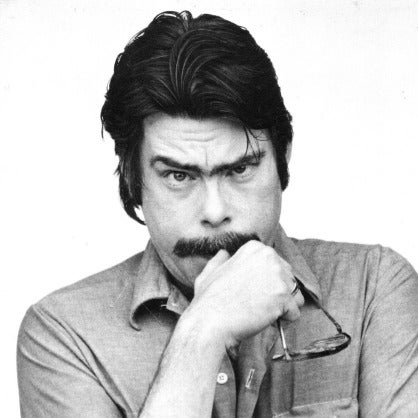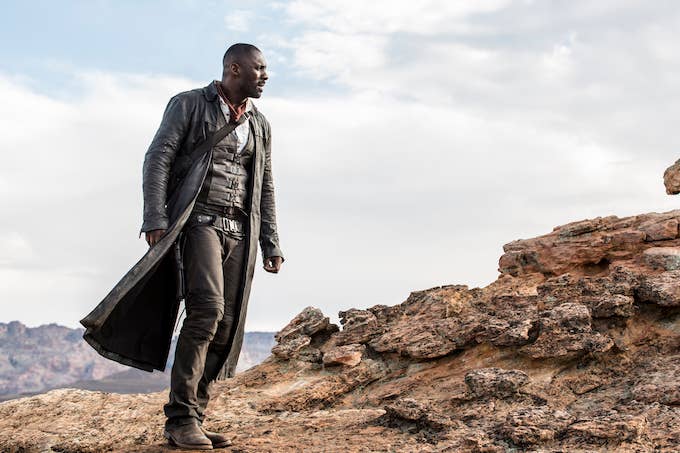
Stephen King's The Dark Tower is finally getting a movie after an 11-year, high-profile slog through all nine circles of development hell. It's a familiar title, but its sweeping, hard-to-summarize concept and massive time commitment have always hindered it from being a widespread King conversation piece. Since it's no It(shapeshifting clown), Carrie (blood, prom, fire), The Shining (c'mon), or Misery ("Stan," if he kidnapped Eminem), here's how any non–Constant Reader can bond with that person sitting next to them in the Lobstrosity costume.
What is 'The Dark Tower'?
King's one and only series of novels (until his recent soggy detective trilogy), begun when he was in college and concluded at age 57. It's a rainbow of writing styles—hardly ever landing in the Master of Horror's traditional wheelhouse—as well as genres, particularly fantasy, sci-fi, western, and just "adventure" generally.
What's the Tower itself?
It takes till the end to really grasp its nature (if even then), but it’s essentially the structure that holds all existence together. It's held up by six magical Beams the bad guys are trying to destroy. It's in a humongous field of roses and reaching it is the sole purpose of Roland Deschain of Gilead, the last Gunslinger.
How many books are there?
Seven originally, eight after King surprised us with a Book 4.5 in 2012.
Any extra reading I should do?
One Roland-starring short story, "The Little Sisters of Eluria." Marvel's released more than 15 graphic novels of new and adapted material. They're plotted by Robin Furth, King's assistant and the author of the one ancillary book you need to read, The Dark Tower: The Complete Concordance.
King's oeuvre connects to TDT in a million ways, ranging from crossover characters to nerdy little winks to tools for interpreting the otherworldly elements of his 70+ books. But! You don't have to pick up a single other SK tale to wholly enjoy TDT, and if you do, don't stress about which order to read them—there are merits to any path. Majorly related works include Insomnia, It, 'Salem's Lot, The Stand, "The Mist," Hearts in Atlantis and the Peter Straub co-written The Talisman and Black House.
Where is it set?
Aside from Earth (with lots of NYC, some Maine) in its many cosmic versions, it’s set in Roland's Mid-World and End-World, which have "moved on." The progressive metaphysical desolation makes time and direction wobbly in untraceable ways. There was spectacular technology and powerful magic ages ago, but it's long gone. Our Earth bleeds into Mid-World in quirky ways: "Hey Jude" plays in a saloon, the ruins of a Citgo loom near a village.
When is it set?
The film looks like modern day. In the books, on the Earth we know, they hopscotch around America from the 1960s onward.
Who should I know?
Roland Deschain (Idris Elba): The last Gunslinger, which was an order of knight-like protectors in the kingdom of Gilead, long fallen. He's serious, mysteriously ancient and wise, and an unsurpassed deadly shooter.
Jake Chambers (Tom Taylor): Roland's child companion from Earth. He's got the
Touch, which is akin to the Shine.
The Man in Black (Matthew McConaughey): As The Dark Tower is King's magnum opus, Walter O'Dim—a.k.a. the Walkin' Dude, or Randall Flagg, or tons more aliases—is his über-villain. Rights issues might prevent the TDT film from referencing it, but MiB's the central villain of The Stand and menaces other stories. (McConaughey was also rumored to play Flagg in the Stand movie they're trying to make.)
The Crimson King (movie presence TBD): The big universal evil, and the Man in Black's boss. Like the Tower, we don't have much of a tangible understanding of him until we're deep into the saga, but we do know he wants to stop Roland and ruin the Dark Tower.
Eddie, Susannah, and Oy, the rest of the ka-tet, Roland's destiny-bound fellowship (not on-screen this time): These three are on the journey to the Tower with Jake and Roland. Eddie and Susannah arrive in Book 2, she with dueling personalities at first, Odetta and Detta. Oy is Jake's adopted billy-bumbler, which is like a raccoon-dog with limited, adorable speech capabilities.
Susan Delgado: Roland's true love, killed just as their short teenage love affair was getting started. (Their romance is almost all of the flashback-y Book 4, Wizard and Glass.)
Advanced Faking 'The Dark Tower' Knowledge
–The opener—"The man in black fled across the desert, and the gunslinger followed"—is Stephen King's most-loved sentence
–Everyone wants Aaron Paul to play Eddie, including Aaron Paul
–King published the last three books in 10 months, having written them all (2,000 pages!) in a burst after a van struck and nearly killed him
–A contingent of fragile-minded, canon-clinging folk are upset Idris Elba's playing Roland because Susannah, who is black and comes to Mid-World from the mid-1960s, at first vehemently rejects Roland and calls him "honky" a lot. It’s a foolish complaint that’s easily tweaked
–Oy must be revered at all times, passionately
Why does it matter?
The books have spanned King's entire adult life, and you can creatively apply their mythology to almost all his works.
In the context of literature overall, its ending is an experience you'll never find elsewhere. The Dark Tower runs more than 1 million words; they're all worth reading just to get to the final few.
As a movie? Because it's finally happening, and no matter the result, Elba's gonna be astonishing as Roland, and there'll be cool King references and some marvelous imagery. And in its glorious, interdimensional what-the-fuckery, it's a sequel to the books. If The Dark Tower's now on your reading list, don't forget the face of your father by googling it.

